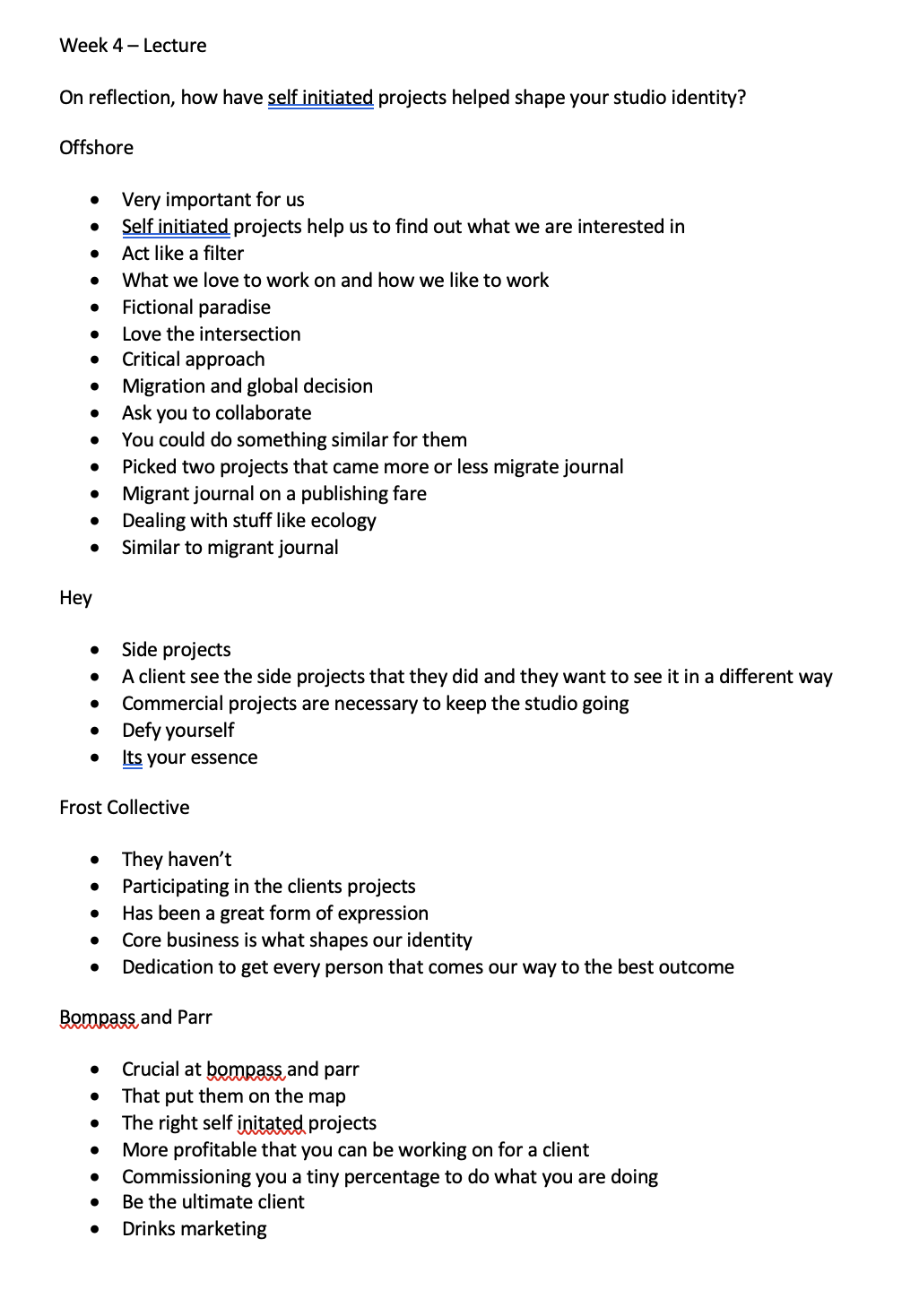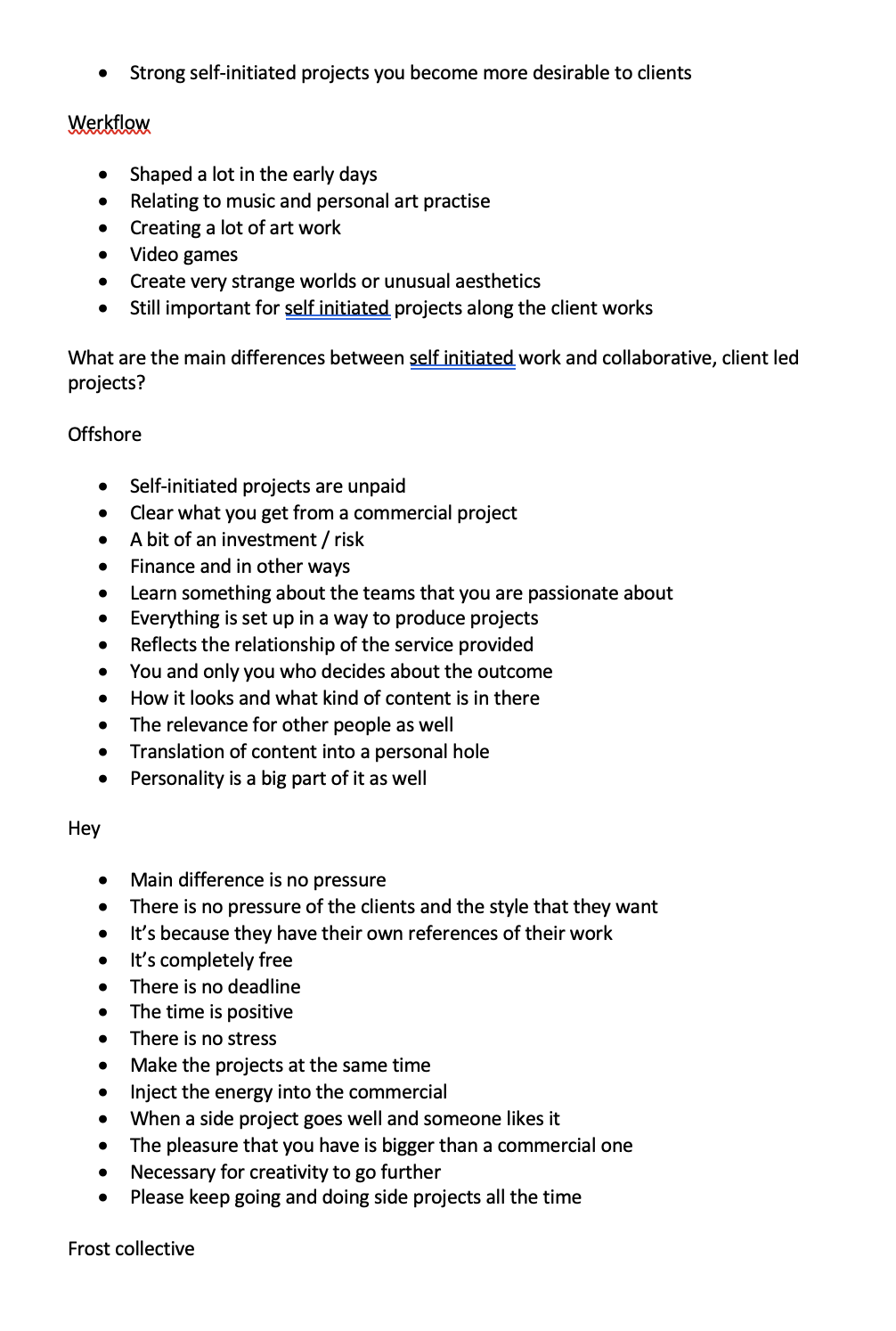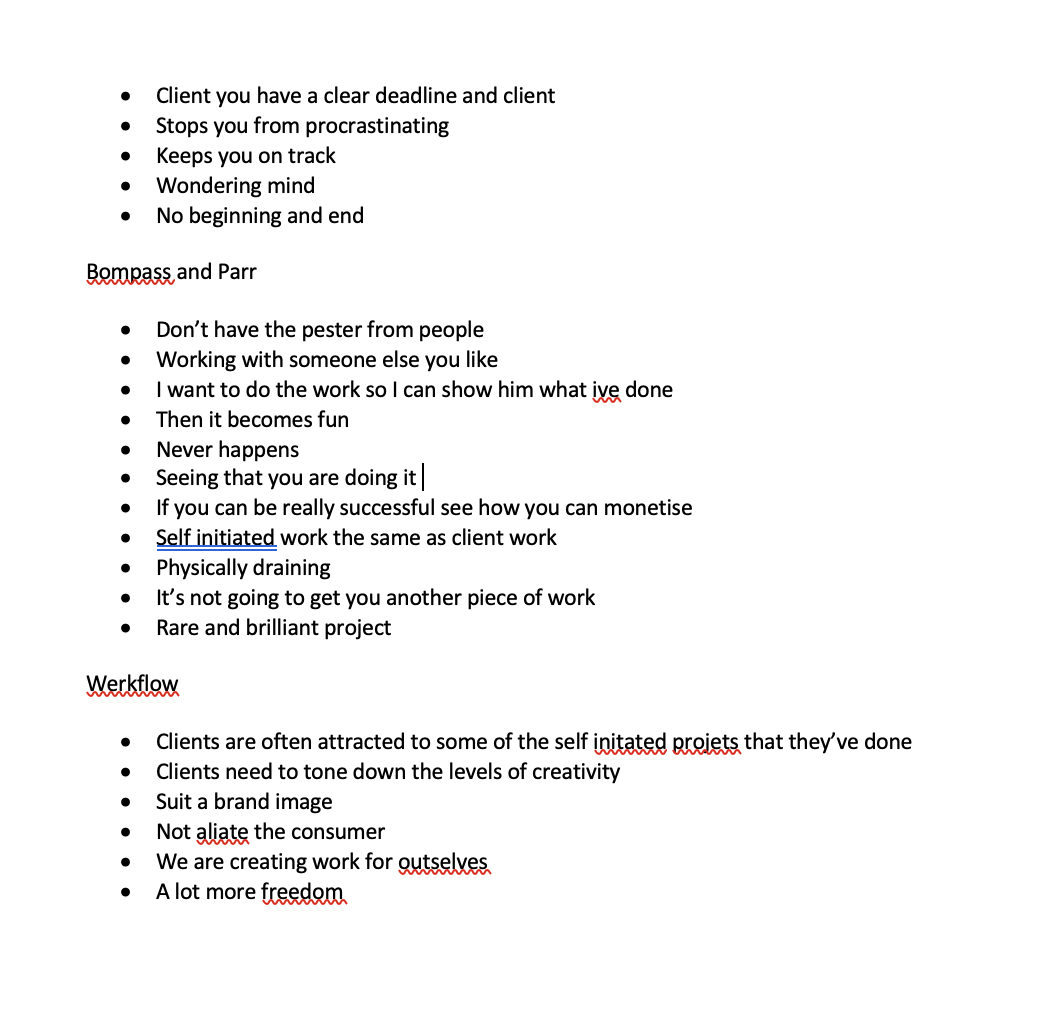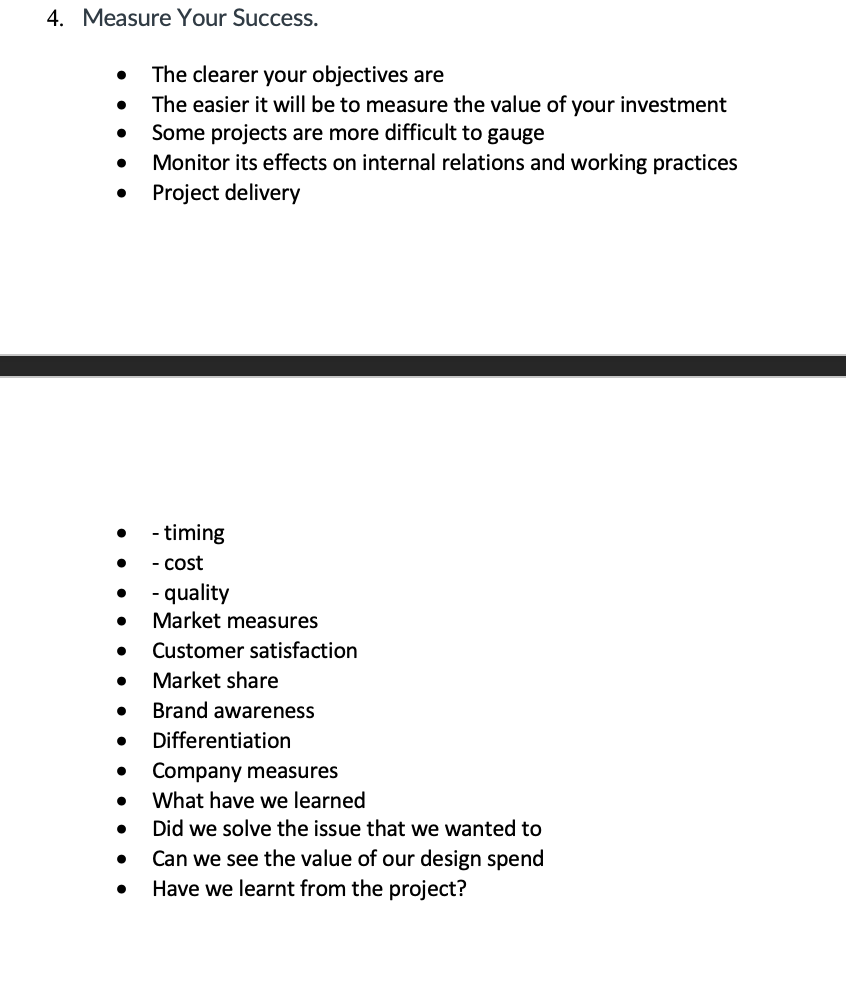Week Four
Lecture Notes:
Lecture Reflection:
This weeks lecture looked at two different questions; firstly looking at how it’s shaped your studio, a lot of the answers were that it hasn’t but for clients it’s been able to get them on the map to get the bigger projects or the smaller projects. A lot of the time they have been able to get clients from doing self initiated work that you can then apply similar design thinking to that proejct. The second question was What are the main differences between self initiated work and collaborative, client led projects? and a lot of the answers for this was being paid. The main answer that i really liked was the fact that with a client you are being nagged all the time but with a self initiated you have the freedom and the control to do what you like to do.
Resource Notes:
Resource Reflection:
R1-3:
This resource I found super moving, based around a product for dementia patients that would allow them to be taken back in time to when this was. The fact that its 360 degrees that would allow the viewer to never see the same thing twice. The who thing around the idea is to allow people to then have a mutual conversation. It was also interesting to learn about the fact that this was a self initiated project due to the founder’s dad having dementia. They made sure to make it accessible but also they are making a new one. What an interesting case study!
R4:
Article on measuring success, really helpful to use when it comes to looking at this for this weeks workshop task!
Research:
How have your expectations for the final project changed or developed? Has your personal relationship with your designated subject changed over the course of the project?
Supergraphics
https://www.printmag.com/design-books/su-sup-super-graphics/
Weekly Workshop:
Finalise the design of your self-initiated project.
Write short notes to evaluate the success (or failure) of your self-initiated project and ensure you articulate the project’s relationship to your own personal practice, interests and creative identity.
Gather feedback from your target audience and reflect on what worked, what didn’t work and what you would do differently. Engage in discussion on the Ideas Wall and add your reflective notes to your blog.
Record a five minute video presentation to evaluate the success (or failure) of your self-initiated project. We want you to reflect on the different stages, from concept development to final outcome, and demonstrate how your project has evolved over the last four weeks. We want you to evaluate your project and gain a fresh insight.
Record your presentation in the format of your choice (for example, a voice recorded Keynote or Powerpoint slide presentation, video recording or podcast).
Upload your video presentation to your blog
I began this week by creating a presentation layout for the presentation and also making summary notes for what worked and what didn’t work:
Summary
what did i do
I worked through a design process that began with research and ended in the prototype project.
how did i do it
Through research and reflection about answering my question.
what worked
I feel that the design of the exterior and interior of the redesign of the site worked really well.
what didnt work
The concept didnt work to begin with and then I worked on it.
what would i do differently next time
I would’ve started with the feedback, so that it was able to collect over time.
what would i do to extend the project
I would continue to get feedback and take the project to the next stage which isnt the design stage.
did it achive its aims
I felt it did achieve its aims that it was meant too, for the first part of the project.
I then went on to make this into a video using the following notes:
In this video I will be presenting my self initiated project, which involved creating a design response to improve the local community.
My research started by looking at case studies that involved different self initated projects.
I used the &Walsh article from a previous module, which looked at how to brain storm ideas. This involved looking at the things I was passionate about and things that I thought needed improving within the world. I then combined all the ideas I had onto one big mind-map.
From the mindmap, I came up with 4 different areas that I could pursue within the 4 weeks.
In the end I chose the following; Can reusing an abandoned space within the local area bring the community back together again. Due to this question being fairly big for 4 weeks, I had a sub question of Can design fulfil the community needs? This idea was based around an abandoned building that was near where I lived.
Taking from inspiration from Daniel Eatock’s collaboration work within the community ,I wanted to see what other community projects had previously been done in different design sectors.
After exploring these case studies, I came up with some questions that allowed me to think about the community that surrounded the site.
This led me to focusing on an architectural and graphical response.
I developed my idea by doing the following; Site research, Audience research and Place making research.
I began to do some background research on the sports centre and the try to find out the history of the building. The land of the sports centre was donated to the people of Southampton in 1938 and is used primarily for recreation and sporting.
There is a 18 hole golf course a ski slope an athletics tracks, football pitch, netball court tennis court and atstro turf aswell as mini golf and dirt bike course. The area lacks any indoor facilities.
Unfortunately there are no building records for the derelict building which previously had been an ice cream stand.
I also did some research on the proposed regeneration plan by Southampton city council
Audience research from a previous survey of the site people said they were keen to have more varied spaces within the centre and also to develop the areas across the site that have become derelict.
The main research on place making was from the project for public spaces that allowed me to understand the needs of making a great space which includes involving the local community.
Half way through the project, I decided to change the direction of my concept as I felt it did not answer the research question that I had posed.
I reviewed my research and it led me to re focussing on creating a prototype space that would allow the community to test ideas that they want to see within the regeneration project that the council had proposed.
I went onto develop a design proposal plan that I could eventually submit to the council about this concept. The plan included how the exterior of the space could be regenerated to make the space usable to the local community, to do this, it would need a new roof and sky lights that would allow light to enter the space. I would also make sure that the windows within the current building were filled for privacy and security of the space.
Within the interior of the space, I intend to make it as multi functional as possible. Including wall dividers and open spaces that can be used for a different functions at the same time. I would also have storage and a bathroom that would be accessible to the users of the space.
Throughout the prototype project, I received feedback from the surrounding community about their thoughts on the project. The feedback was positive and people were already suggesting ideas that they could use for the activities. The type of activities that were suggested were generally social activities including; yoga, knitting and stitching, craft work, games, kids club, athletics, mums and babies as well coffee club.
If I had more time, I would have tried to be more specific with the questions that I asked but also send survey to more people. This would have allowed me to further the design of the building but also have a deeper understanding of the local needs.
To allow for feedback throughout the project, I would create two different ways for the community to input their ideas for what they would like to see at the centre. The first way would be through a website and the second would be within the centre itself. The strongest part of the project is that it’s by the community for the community
If I was to extend the project, I would have worked with local artists to create a mural for the exterior site as well as worked more on the visual identity. I would have liked to ask the opinions of the council member who might be able to give me a budget and time scales as well. The response that I have created in this project is just the outline plan for the beginning ideas of the proposal, so this could be developed further taking it to the next stage with the councils input.
Weekly Reflection:
On reflection of the project over the past four weeks, I have enjoyed being able to re-design this abandoned building that would help my local community, which I feel would make a difference.
The project has answered the first part of the research question, answering Can design fulfil community needs? of the bigger research question Canreusing an abandoned space within the local area, bring the community back together again? Away from answering the question, I feel I have fulfilled my own personal design goals with this project, creating a design that actually means something to the community.
I have enjoyed creating different parts to this design, the exterior, interior and the visual identity. The prototype project could go on for years or even months depending on the amount of engagement. It could then also be adapted to be a part of the new design when the park gets regenerated.
The strongest part of the project for me was the interior and exterior reuse of the space. If I had more time I would have spent time creating a mural for the exterior of the building working with local artists within the community, as well as working more on the advertising and visual identity side.




